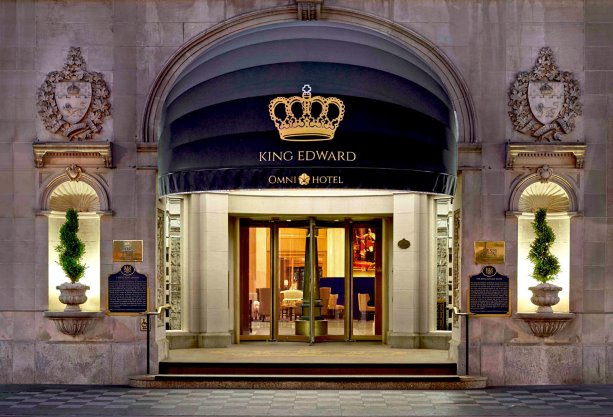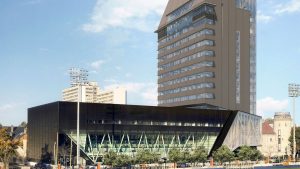The exterior restoration of the Omni King Edward Hotel’s masonry wrapped up last spring bringing the $40 million refit of the iconic hotel closer to completion.
Guests have been welcomed back since last September, but work still continues inside the King Street East hotel in Toronto.
"They’re just getting ready to work on the Crystal Ballroom," said ERA Architects partner Edwin Rowse of the 17th floor space which first opened in 1922. Omni has budgeted $6.5 million for the project.
If it goes as well as the exterior repairs and refit, it will be spectacular, he said.
ERA and contractor Historic Restoration completed their project last spring on time and under budget, said Rowse, though there were a few surprises.
"The biggest was that some of the terra cotta had been replaced, which we knew, but what we discovered was that it was fibreglass," said Rowse. "That was a surprise. You couldn’t really tell until you were right up on top of it. They actually did a very good job of it."
At the outset of the project in 2012, the initial work was investigative to see what the extent of the repairs would have to be.
The original hotel was built in 1903 but the tower was constructed 20 years later using completely different construction technologies, Rowse said.
The 1903 structure was the first of the grand "palace"-style luxury hotels, with marble opulence and cost about $3 million at the time. Its big boast was that it was "absolutely fireproof" given the masonry construction.
There were two architects who had their hands in designing the King Edward, American Henry Ives Cobb and Toronto’s E. J. Lennox. Cobb started an exterior design but was dismissed later with no explanation, according to An Illustrated History of the King Edward Hotel by Sally Gibson, a heritage consultant in Toronto.
She notes the height of the building was set at eight storeys with 400 rooms, despite concerns guests would not feel safe that high off the ground in the event of fire. Six had been originally suggested by Cobb before his departure.
The 18-storey addition started in 1921 to add another 530 rooms and the Crystal Ballroom. Gibson describes the design by Esenwein and Johnson of Buffalo with Watt and Blackwell of London, Ont. as "frankly utilitarian."
The addition was completed in 18 months, record time even then.
The original 1903 structure was built with localized steel, mostly as lintels, said Rowse, while the newer one was an adventurous design with a steel frame and curtain walls used for the first time in Toronto. But with the corrosion of the steel there had been some shifting and there was a lot of damage as a result because there was a lot of weight and pressure on the masonry. As such, the contract with the owners was extremely flexible with an overall ceiling, but was to be priced as worked progressed and according to the nature of that work.
"I don’t think a public owner would work like that and even for a private owner it would be very difficult but they understood the challenges," said Rowse.
With only a rough idea of the challenges ahead work started slowly but soon picked up as crews and architects started to see a pattern in the damage and developed a process to remove and repair materials.
"We went elevation by elevation and we started to see what was needed so we created a tool box system," said Mikael Sydor of ERA.
The bricks had "taken a hell of a pounding over the years" but stood up fairly well, said Rowse, noting that as they got to the top there was more terra cotta. That’s where most of the damage was found because it doesn’t stand up as well to the elements and pollution, he said.
Ironically, terra cotta was introduced as a building material with the promise of longevity and the ability to weather erosion.The cost today of terra cotta is prohibitive so any pieces needing replacement have been recreated with precast, said Rowse.
Existing precast components, however, also caused some problems.
"The precast pieces are cementitious and over time have become carbonized and thus alkaline and started corroding the steel," he said. "We had to take them out and coat the steel with epoxy to protect it."
ERA is well versed with the King Edward, having been retained a decade ago to map out a renovation of the Crystal Ballroom which was put on hold during the 2008 global financial crisis. The following year, however, it was the lead consultant on the addition of 140 condos on the third, fourth and fifth floors, which involved stripping the interior back to the steel frame.
During the most recent phase, they enlarged some of the windows and converted others to balcony doors.
ERA also refurbished the 300 guest suites and public spaces as well as the lobby, and two other ballrooms.
"I really can’t say enough about Paul Goldsmith of Historic Restoration, he is absolutely wonderful to work with," said Rowse. "He has brought along some really good people through the company much in the same way as he did a full five-year apprenticeship when he first started in the craft."
There are some features the public will never see but brought a smile to the crews and architects, such as the flashings along the parapets.
A terra cotta parapet feature with elegant carving details and varying planes was taking on frequent water damage and needed protection going forward. Flashing was the answer but modern day aluminum just wouldn’t bend properly with the carved features and rolls.
The solution was old school: lead.
"We went with lead and we found some guys who could lay it down," said Rowse. "It really is a skill and it looks great. Of course, only the pigeons are enjoying it, but it’s great to know there’s another 100 years there."




Recent Comments
comments for this post are closed